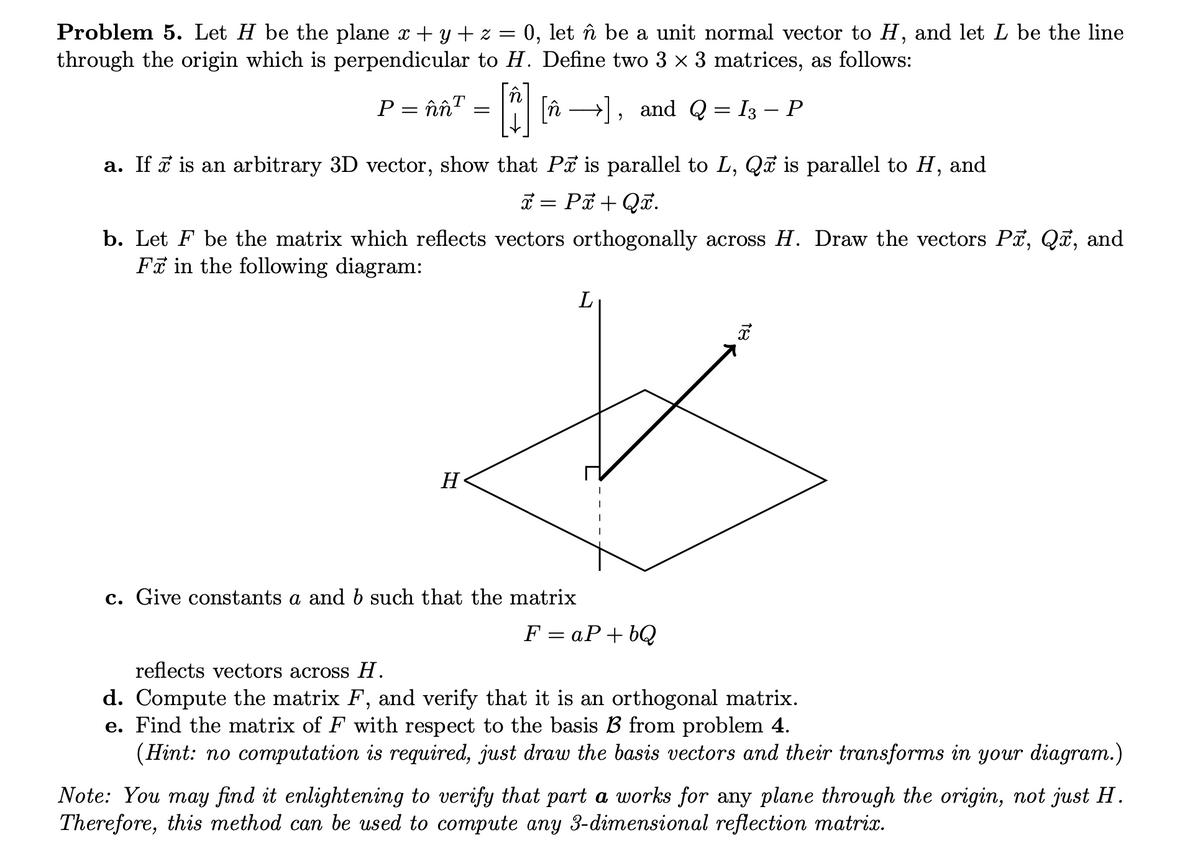Problem 5. Let H be the plane x + y + z = 0, let în be a unit normal vector to H, and let L be the line chrough the origin which is perpendicular to H. Define two 3 × 3 matrices, as follows: P = îî™ Q = I3 – P a. If i is an arbitrary 3D vector, show that Pi is parallel to L, Qã is parallel to H, and * = Pa + Qã.
Problem 5. Let H be the plane x + y + z = 0, let în be a unit normal vector to H, and let L be the line chrough the origin which is perpendicular to H. Define two 3 × 3 matrices, as follows: P = îî™ Q = I3 – P a. If i is an arbitrary 3D vector, show that Pi is parallel to L, Qã is parallel to H, and * = Pa + Qã.
Linear Algebra: A Modern Introduction
4th Edition
ISBN:9781285463247
Author:David Poole
Publisher:David Poole
Chapter4: Eigenvalues And Eigenvectors
Section4.2: Determinants
Problem 10AEXP
Related questions
Question
parts a ) - d). For d) can you just compute the matrix F? I can prove that they're orthogonal. Please. I need help.

Transcribed Image Text:Problem 5. Let H be the plane x + y + z = 0, let î be a unit normal vector to H, and let L be the line
through the origin which is perpendicular to H. Define two 3 x 3 matrices, as follows:
P = înT
I A →), and Q = I3 – P
a. If i is an arbitrary 3D vector, show that Pã is parallel to L, Qã is parallel to H,
and
T = Pi + Qã.
b. Let F be the matrix which reflects vectors orthogonally across H. Draw the vectors Pi, Qĩ, and
Fa in the following diagram:
H
c. Give constants a and b such that the matrix
F = aP+ bQ
reflects vectors across H.
d. Compute the matrix F, and verify that it is an orthogonal matrix.
e. Find the matrix of F with respect to the basis B from problem 4.
(Hint: no computation is required, just draw the basis vectors and their transforms in your diagram.)
Note: You may find it enlightening to verify that part a works for any plane through the origin, not just H.
Therefore, this method can be used to compute any 3-dimensional reflection matrix.
Expert Solution
This question has been solved!
Explore an expertly crafted, step-by-step solution for a thorough understanding of key concepts.
Step by step
Solved in 4 steps

Knowledge Booster
Learn more about
Need a deep-dive on the concept behind this application? Look no further. Learn more about this topic, advanced-math and related others by exploring similar questions and additional content below.Recommended textbooks for you

Linear Algebra: A Modern Introduction
Algebra
ISBN:
9781285463247
Author:
David Poole
Publisher:
Cengage Learning

Linear Algebra: A Modern Introduction
Algebra
ISBN:
9781285463247
Author:
David Poole
Publisher:
Cengage Learning